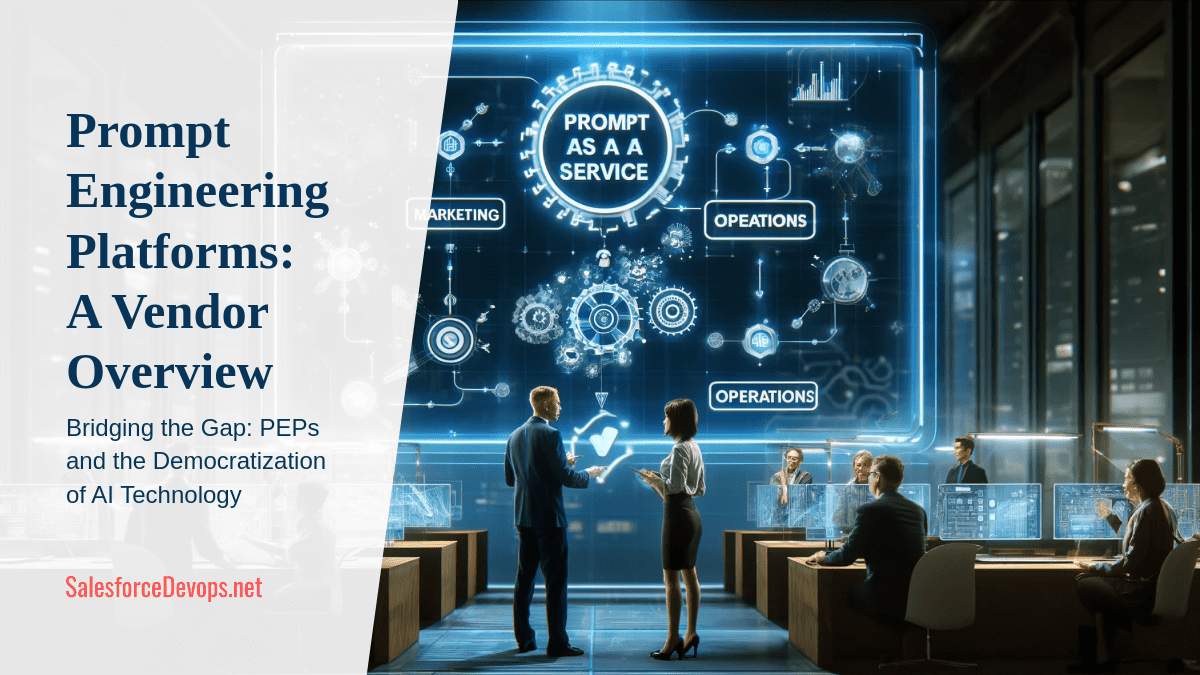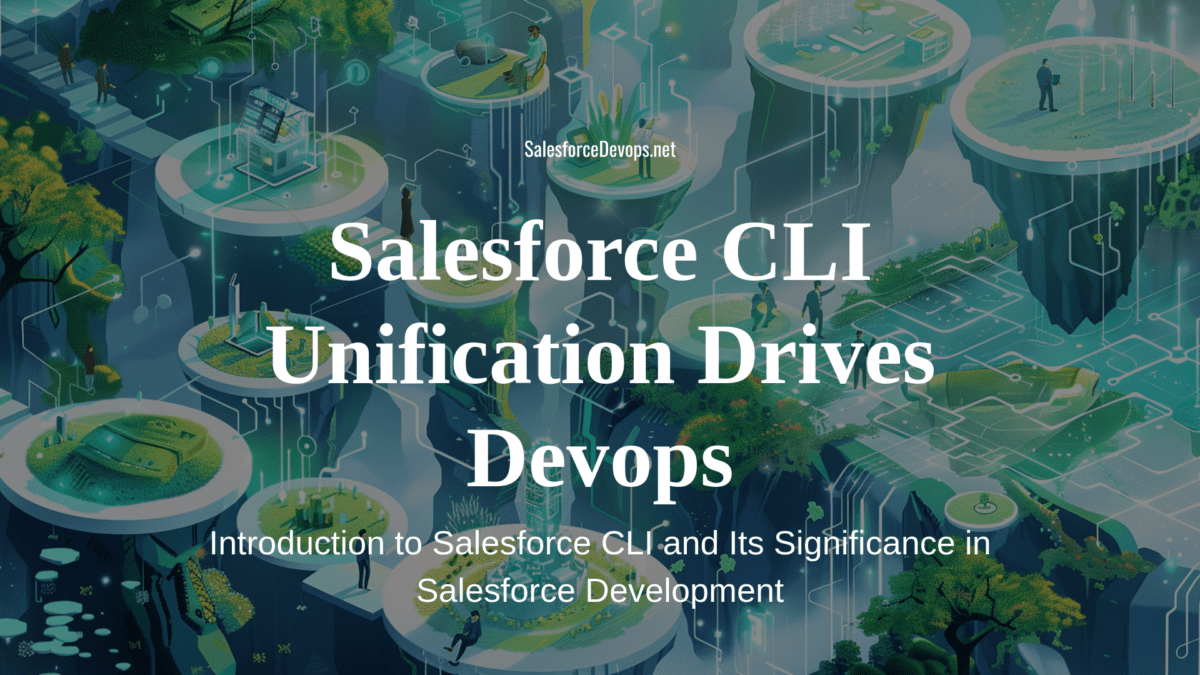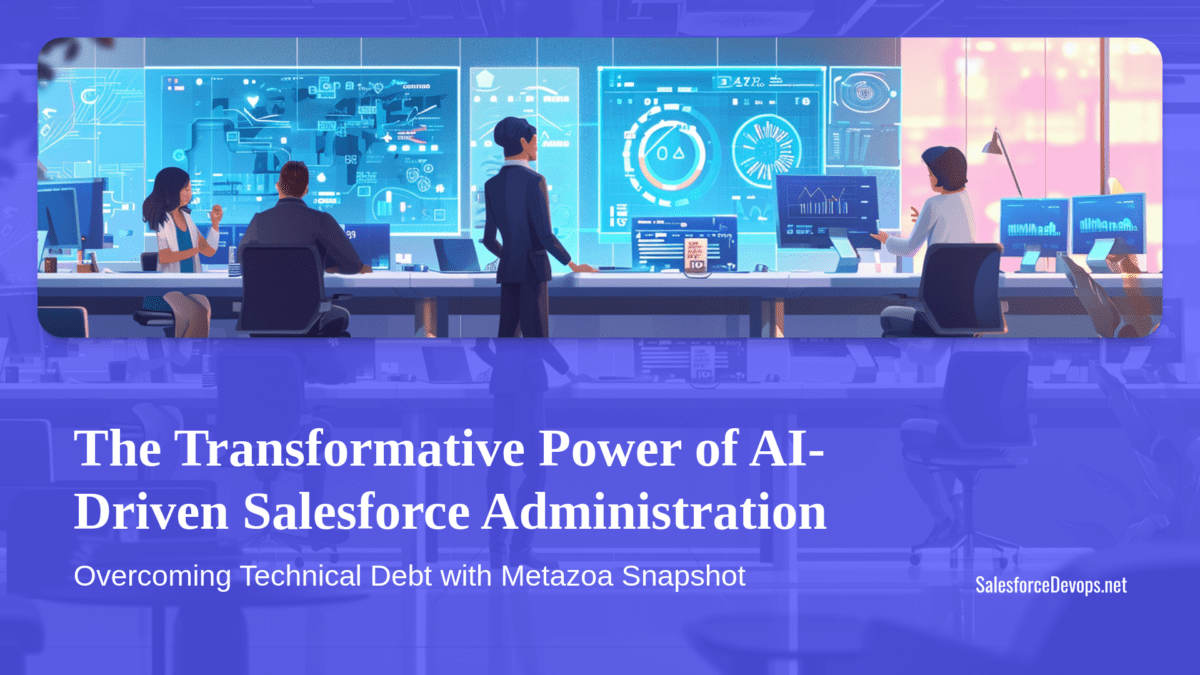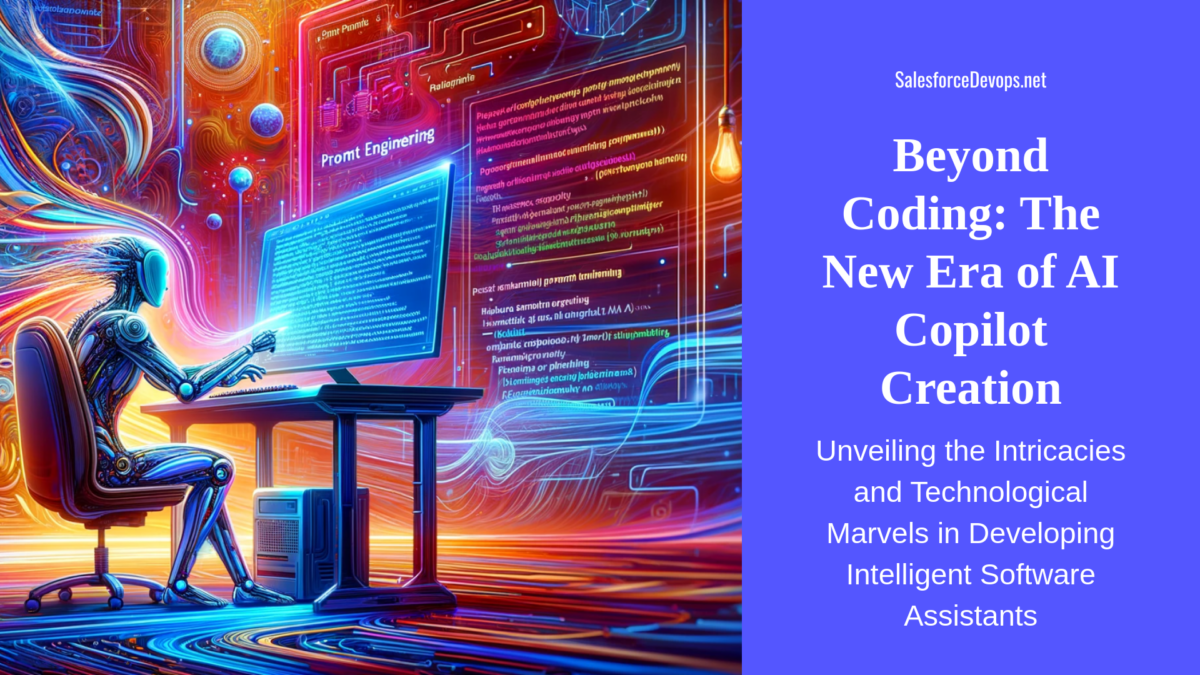Salesforce Devops Outlook 2023: We are Just Getting Started
As we go into an uncertain 2023, Salesforce devops stands out as a new and growing emphasis for IT organizations. In this overview of the field, I lay out what devops means for different parts of the Salesforce customer base. After reading this article, you should know what to do next if you want to exploit devops in your Salesforce strategy.
What is Salesforce Devops?
We can spend an entire article defining the terms devops and Salesforce devops. But let’s keep it short. Here is an aspirational definition of Salesforce devops which emphasizes what devops is supposed to do and how to do it.
Salesforce devops is a management program that oversees the software, data, and activities that continuously builds better Salesforce apps faster.
I’ve packed a lot of meaning into each word of this definition. But the part I want to emphasize here is the phrase “builds better Salesforce apps faster.” I believe that phrase identifies what anyone involved in Salesforce devops wants to bring to their organization.
How to Build Better Apps Faster
Salesforce devops has done well by addressing the complex processes involved in Salesforce release management. This has helped us to build apps faster, but how do we build them better? Here is a somewhat cryptic answer to that question: Apps are built better by connecting their performance to enterprise value streams. This means metrics about an app’s performance needs to be linked to key performance indicators.
So, Salesforce app development still needs a value stream revolution to truly prove its worth. Technical debt and useless development activities must also be eliminated by effective use of business process analysis. And the whole process of managing app development teams needs to be optimized with application lifecycle management (ALM) practices.
In other words, we are getting better at using Salesforce devops for faster release management. But we still have a way to go before devops investments are known to be driving enterprises forward.
Salesforce Devops Market Segmentation
Let’s figure out what you need to do next if you’re interested in using Salesforce devops. Listening to marketing messages can be confusing because most of the content comes from the vendors. Let’s put Salesforce devops into your own personal perspective.
To help get the right focus, here is a lens from which you can view these messages. Start by putting yourself into one of these four slices of the Salesforce market.
- Very Large Enterprises – These are organizations with revenue or budgets in the tens or hundreds of billions of dollars. They can be federal governments or multinational corporations.
- Large Enterprises – These are multi-billion-dollar national organizations which are typically state or provincial governments or national brands.
- Small to Medium Enterprises – These are organizations with annual revenue or budgets from $10 million to less than $1 billion.
- Small Businesses – In the United States this segment represents up to 10 million individuals and small organizations with less than $10 million in annual revenue or budget.
Next, here is a breakdown of key Salesforce devops skills required by each segment. Scan down your column in this matrix to get an idea of what you might be missing in Salesforce devops. Also, this matrix illustrates how everyone doesn’t need to know everything about devops.
| Salesforce Devops Skill | Very Large | Large | SME | Small Business |
| Value Stream Management | Yes | Optional | No | No |
| Application Lifecycle Management | Yes + Teams | Yes + Teams | Yes | Optional |
| Observability and SRE | Yes | Yes | Optional | No |
| Pipeline Orchestration | Yes + Golden Path | Yes | Optional | No |
| Release Management Tooling | Yes + Vendor | Yes + Vendor | DevOps Center | DevOps Center |
| Artifact Repositories | Yes | Yes | Yes | Yes |
Let’s discuss these Salesforce devops skills and see how they break down according to your organization size. Use this information to help you decide what next steps your organization needs to take on the devops roadmap.
Value Stream Management

The value delivered to enterprise stakeholders usually defines enterprise value. To understand enterprise value, Value Stream Management (VSM) is used by very large and large organizations to identify and promote the factors that produce enterprise value. VSM was inspired by a system known as the Toyota kata, which was created to manage manufacturing and management processes for the Japanese automaker in the 1970’s.
In very large organizations, a center of excellence (CoE) usually plays a prominent role in running a VSM strategy. In this case, VSM specialists facilitate group analysis which identifies the details involved in enterprise value streams and how to measure them with key performance indicators (KPIs). The CoE strategy works here because it gives VSM practitioners a global view of the enterprise.
Application Lifecycle Management

The pandemic sped up the adoption of an Agile-inspired and Lean-patterned management style. This led to a remote work revolution driven by tools like Trello, Jira, and Slack. The Toyota kata philosophy, which invented Kanban boards, queue management, and messaging, provided inspiration for those tools. As a result, planning tools, epics, user stories, business analysis, task management, and messaging systems now make up the essential management toolkit for software development today.
The imperative for using ALM varies greatly by organization. Startup companies are now frequently organized and operate based on ALM. Ironically, the largest organizations are usually in the direst need for the better communication offered by ALM. But cultural rigidity often restricts big organizations from adopting such management programs. It usually takes a revolution in an organization’s management philosophy to let software development teams exist in an environment needed to create mission-critical projects effectively.
Recently, though, devops philosophies have percolated up into the enterprise realm. These ideas are often exemplified by the Team Topologies concept, which uses the proverbial two-pizza sized teams. Some believe that only when tightly knit teams have the authority and the safety to make their own decisions, can a massive set of teams in an enterprise work together.
Observability and System Reliability Engineering (SRE)

A frequently overlooked key function of Salesforce devops is to know what is happening with your applications. And if you are collecting data on what is happening to your application, you also need to have systems that analyze and respond to that data.
Most Salesforce users don’t seem to care about observability or SRE because Salesforce usually takes care of the job for them. However, log file generation, analysis, and incident response become more important as there are more critical Salesforce applications involving integrations with other online systems.
But truly, only the larger Salesforce org or those with critical applications need to seriously care about advanced reliability monitoring. So, if you are in the SME or small business customer segments, your observability concerns are likely limited to incident detection and response.
Pipeline Orchestration

Organizing people and code around a sequence of development, deployment, and testing activities forms the core of Salesforce devops pipeline orchestration. To deploy new features, larger organizations need a sophisticated, branch-based pipeline management system. To get the job done, these organizations use scripted command servers, commonly known as CI/CD engines.
A cursory examination of Salesforce DevOps Center may give one the impression that it can run multi-step devops pipelines. However, DevOps Center does not have all the features required for it to be a complete pipeline management solution. While it is an adequate replacement for change sets and older Salesforce deployment technologies, it does not allow for crafting a custom, event-driven pipeline management system. After all, DevOps Center is a tool, not a platform.
So, most larger organizations need a customizable, scriptable pipeline engine. But creating a devops pipeline is challenging due to the myriad of vendors and choices available.
To address pipeline challenges, the better larger organizations leverage their CoE networks to provide developer experience (DX) services to their app creator communities. In the case of devops pipelines, these organizations practice platform engineering to deliver a Golden Path to their developers. The Golden Path is an opinionated methodology for accomplishing complex IT activities that normally involves a vendor showdown.
Release Management Tooling

The real challenge in Salesforce application development remains performing the complicated chore of deploying metadata to a live org. Because of this complexity, using an external SaaS system to manage your critical SaaS systems makes sense. To meet this need, Salesforce devops platform vendors help users deal with a live Salesforce org and all the complexities of its metadata system. I’ve identified seven vendors who have Salesforce devops platform offerings. Those vendors are AutoRABIT, Blue Canvas, Copado, Flosum, Gearset, Opsera, and Prodly.
Now, with Salesforce DevOps Center, users have a “native” Salesforce feature to access the source code change management features of Salesforce DX. And while DevOps Center is not a pipeline orchestration platform, it certainly is a nice release management tool for the Trailblazer community.
So, when can you get away with just using DevOps Center? And when do you need to use one of those platforms? It varies based on your use case, and each offering has its own strengths to consider. But it is only larger organizations that use pipeline orchestration that should investigate the whole field of Salesforce devops vendors.
The SME and small business segments do have some simpler choices with products targeted to individual developers. Gearset and Copado Essentials have pricing plans and target audiences which fits those markets. Also, Prodly is particularly accessible to business creators, and it is useful for orgs managing AppExchange setup data.
But for the majority of SME and small business customers, Salesforce DevOps Center should be used as a starter tool for better release management.
Artifact Repositories

A universal need for anyone doing organized Salesforce release management is an artifact repository. For example, if you are using DevOps Center, you need to have a GitHub account for DevOps center to store information related to release management.
We usually refer to an artifact repository as a source code repository or a source of truth. But I don’t like to use those words when referring to the stuff we put into repositories during Salesforce release management. Saying you are building a source of truth is confusing in Salesforce, and it gives people the idea they can collect all the metadata used to recreate a complex org, which is hard to do.
For example, when using DevOps Center, you use GitHub to store a change artifact derived from a sandbox which is used later in a Salesforce deployment activity. If you look at the information DevOps Center has put into GitHub, it is usually an XML document, which is not what one normally calls source code. That XML is a representation of a change you want to make to Salesforce. That’s why I call them change artifacts instead of source code.
Nevertheless, no matter what you want to call them, GIT repositories are now a basic part of Salesforce release management. Starting today, every org that wants to get off change sets needs to get organized on GitHub.
Devops Does It All!
I hope you’ve enjoyed this Salesforce devops outlook for 2023. Unfortunately, the term devops has become a catch-all term used to encompass all aspects of enterprise application development. As you can see from this article, Salesforce devops covers a huge range of topics ranging from value stream management to managing XML files in a GitHub repository.
While we have made strides in building our apps faster with Salesforce devops, we still have a way to go making apps better. For organizations who want to link devops to enterprise value, look at application lifecycle management (ALM) and value stream management (VSM) as ways to help build apps better.
Since only the bigger organizations care about advanced devops topics, smaller organizations do not need to think so high-mindedly about devops. Maybe some for them, merely the introduction of DevOps Center into their workflow will create better organized release management.
Hopefully by breaking down the stack of Salesforce devops solutions by your organization size, I have given you a slightly clearer devops roadmap. Let me know how your organization is going to use devops to build better apps faster in 2023!






